Study of Estimated Ultimate Recovery Prediction and Multi-Stage Supercharging Technology for Shale Gas Wells
Abstract
:1. Introduction
2. Theoretical Research
2.1. The Selection of the Supercharging Mechanism and Mode
2.2. Calculation Method of the IPR Curve
2.3. Establishment of a Critical Fluid-Carrying Model for Horizontal Shale Gas Wells
2.4. Establishment of Booster Timing
3. Actual Production Research
3.1. Equipment Selection
3.2. Platform Pressurization Process Effect Analysis
3.3. Platform Pressurization Process Predictive Analysis
4. Conclusions
Author Contributions
Funding
Data Availability Statement
Conflicts of Interest
Nomenclature
| original free gas reserves of the gas reservoir, 104 m3 | |
| free gas reserves in the matrix system, m3 | |
| gas volume factor at primordial formation pressure, m3/m3 | |
| volume constant, m3/t | |
| P | formation pressure, MPa |
| pressure constant, MPa | |
| apparent density of matrix rocks, g/m3 | |
| matrix system porosity | |
| gas volume coefficient at formation pressure P, m3/m3 | |
| natural gas density in the standard state, g/m3 | |
| fracture system compression coefficient, MPa−1 | |
| formation water compression coefficient, MPa−1 | |
| cumulative gas production, 104 m3 | |
| daily gas production in shale gas wells under standard conditions, 104 m3 | |
| standard pressure, MPa | |
| standard temperature, K | |
| S | epidermal coefficient |
| D | high-speed non-Darcy coefficient |
| gas flow rate, cm/s | |
| quasi-pressure corresponding to the formation pressure of the two adjacent fracture centerlines (at the choke boundary), (0.1 MP)2/(mPa) | |
| quasi-pressure corresponding to the crack pressure at the fracturing fracture x position, (0.1 MP)2/(mPa) | |
| critical flow rate of gas well discharge, m/s | |
| A | tank cross-sectional area, m2 |
| Z | gas deviation coefficient under P and T conditions |
| R | universal gas constant, j/(mol·k) |
References
- Mingqiang, W.; Yonggang, D.; Quantang, F.; Tingkuan, C.; Rong, W. Research status of pore permeability structure characteristics and seepage mechanism in shale gas reservoirs. Oil Gas Reserv. Eval. Dev. 2011, 1, 73–77. [Google Scholar]
- Zhou, J.; Tian, S.; Zhou, L.; Xian, X.; Yang, K.; Jiang, Y.; Zhang, C.; Guo, Y. Experimental investigation on the influence of sub- and super-critical CO2 saturation time on the permeability of fractured shale. Energy 2020, 191, 116574. [Google Scholar] [CrossRef]
- Ren, J.; Tan, S.; Goodsite, M.E.; Sovacool, B.K.; Dong, L. Sustainability, shale gas, and energy transition in China: Assessing barriers and prioritizing strategic measures. Energy 2015, 62, 551–562. [Google Scholar] [CrossRef]
- Hu, J.; Khan, F.I.; Zhang, L.; Tian, S. Data-driven early warning model for screen out scenarios in shale gas fracturing operation. Comput. Chem. Eng. 2020, 143, 107116. [Google Scholar] [CrossRef]
- Jacobs, T. Renewing Mature Shale Wells Through Refracturing. J. Pet. Technol. 2014, 66, 52–60. [Google Scholar] [CrossRef]
- Wang, K.; Li, H.; Wang, J.-C.; Jiang, B.; Bu, C.; Zhang, Q.; Wei, L. Predicting production and estimated ultimate recoveries for shale gas wells: A new methodology approach. Appl. Energy 2017, 206, 1416–1431. [Google Scholar] [CrossRef]
- Zongming, Y.; Daoming, D. Technical characteristics of low pressure gas gathering and transportation project. Nat. Gas Ind. 1997, 17, 71–75+11. [Google Scholar]
- Guarnone, M.; Rossi, F.; Negri, E.; Grassi, C.; Genazzi, D.; Zennaro, R. An unconventional mindset for shale gas surface facilities. J. Nat. Gas Sci. Eng. 2012, 6, 14–23. [Google Scholar] [CrossRef]
- Mancini, F.; Zennaro, R.; Buongiorno, N.; Broccia, P.; Chirico, M. Surface Facilities For Shale Gas: A Matter Of Modularity, Phasing And Minimal Operations. In Proceedings of the Offshore Mediterranean Conference and Exhibition, Ravenna, Italy, 23–25 March 2011; p. 158. [Google Scholar]
- Arthur, J.D.; Bohm, B.K.; Layne, M.A. Considerations for development of Marcellus Shale gas. World Oil 2009, 512–513, 36–42. [Google Scholar]
- Kang, C.; Xin, J.; Yuanxing, Z.; Longsheng, Z.; Zhen, X. Current status and enlightenment of surface gathering and transportation technology of shale gas in the United States. Nat. Gas Ind. 2014, 34, 102–110. [Google Scholar]
- Behl, N.; Kiser, K.E.; Ryan, J. Improved Production in Low-Pressure Gas Wells by Installing Wellsite Compressors. In Proceedings of the SPE Gas Technology Symposium, Calgary, AB, Canada, 15–17 May 2006. [Google Scholar]
- Chuanlei, W. Research on Pressurized Gathering and Transportation Technology in Daniudi Gas Field. Master’s Thesis, China University of Petroleum (East China), Dongying, China, 2014. [Google Scholar]
- Josifovic, A.; Roberts, J.; Corney, J.; Davies, B. Reducing the environmental impact of hydraulic fracturing through design optimisation of positive displacement pumps. Energy 2015, 115, 1216–1233. [Google Scholar] [CrossRef] [Green Version]
- Yeten, B.; Castellini, A.; Guyaguler, B.; Chen, W.H. A Comparison Study on Experimental Design and Response Surface Methodologies. In Proceedings of the SPE Reservoir Simulation Symposium, The Woodlands, TX, USA, 31 January–2 February 2005. [Google Scholar]
- Arps, J.J. Analysis of Decline Curves. Pet. Trans. 1945, 160, 228–247. [Google Scholar] [CrossRef]
- Qiulan, Y.; Hai, D.; Dongliang, L.; Chunzhi, L.; Linyao, Y. Study on the law of decreasing production capacity of gas wells. Nat. Gas Explor. Dev. 2012, 35, 41–43+52+84. [Google Scholar]
- Chen, H.; Zhang, W.; Lin, J.; Shao, G.; Zhou, J.; Gao, Y.; Yu, H.; Yu, X. Application of multipole array acoustic logging in volume fracturing effect evaluation. Energies 2020, 112–115. [Google Scholar]
- Zhang, K.; Wang, Z.; Chen, G.; Zhang, L.; Yang, Y.; Yao, C.; Wang, J.; Yao, J. Training effective deep reinforcement learning agents for real-time life-cycle production optimization. J. Pet. Sci. Eng. 2022, 208, 109766. [Google Scholar] [CrossRef]
- Zhang, K.; Zhang, J.; Ma, X.; Yao, C.; Zhang, L.; Yang, Y.; Wang, J.; Yao, J.; Zhao, H. History matching of naturally fractured reservoirs using a deep sparse autoencoder. SPE J. 2021, 26, 1700–1721. [Google Scholar] [CrossRef]
- Zhang, K.; Zuo, Y.; Zhao, H.; Ma, X.; Gu, J.; Wang, J.; Yang, Y.; Yao, C.; Yao, J. Fourier Neural Operator for Solving Subsurface Oil/Water Two-Phase Flow Partial Differential Equation. SPE J. 2022, 27, 1815–1830. [Google Scholar] [CrossRef]
- Qinghua, M. Late pressurization mining technology for development of tight sandstone gas field in western Sichuan. J. Sichuan Univ. Arts Sci. 2007, 5, 43–45. [Google Scholar]
- Jianguo, H.; Xin, Z.; Gang, X.; Xiaofeng, Y.; Yanliang, W.; Lei, P. Analysis of CBM station standardization and skid installation design in Qinshui Basin. China Coalbed Methane 2017, 14, 38–42. [Google Scholar]
- Wanning, S. Discussion on the pressurization process of gas gathering station suitable for the characteristics of Jingbian gas field. Nat. Gas Ind. 2007, 2, 98–100+158. [Google Scholar]
- Zhengfen, L.; Baoli, Z. Research on process optimization of gas gathering station in two-stage pressurization stage of Daniudi gas field. Oil Gas Field Surf. Eng. 2018, 37, 44-4. [Google Scholar]
- Shi, W.; Zhang, C.; Jiang, S.; Liao, Y.; Shi, Y.; Feng, A.; Young, S. In Study on pressure-boosting stimulation technology in shale gas horizontal wells in the Fuling shale gas field. Energy 2022, 254, 124364. [Google Scholar] [CrossRef]
- Xinquan, R.; Tianshou, Z.; Yi, L.; Yongjie, L.; Denghai, W.; Guang, Y. Standardized construction of ground system in Sulige gas field. Oil Plan. Des. 2008, 4, 1–3+6+50. [Google Scholar]
- Zhangbing, C.; Xin, S.; Lin, Z. Low-pressure gas gathering and transportation process. Oil Gas Storage Transp. 2009, 28, 1–3+79+83. [Google Scholar]
- Xinan, Y.; Quanhua, H.; Chengli, G.; Jian, Y. Determination of the timing of pressurized mining in Shaanxi Block 45 of Jingbian Gas Field. J. Oil Gas Technol. 2009, 31, 329–331. [Google Scholar]
- Hua, L.; Xiaohu, H.; Weihong, W.; Yong, Z.; Yandong, G. Study on production capacity evaluation method of quasi-steady-state stage of shale gas fracturing horizontal well. J. Xi’an Shiyou Univ. 2016, 31, 76–81. [Google Scholar]
- Yingxue, S.; Xiaoping, L.; Li, S. The mass balance equation and reserve calculation method of shale gas reservoir considering water-soluble gas. Nat. Gas Geosci. 2015, 26, 1183–1189. [Google Scholar]
- Luguang, L. Overview of natural gas exploration, development and utilization in Sichuan Basin. Situat. Sichuan Prov. 2007, 1, 31–32. [Google Scholar]
- Yuhong, L. Research on Drainage and Production Technology of Horizontal Well of Shale Gas in Changning; Southwest Petroleum University: Chengdu, China, 2019. [Google Scholar]
- Min, L.; Ping, G.; Guangtian, T. A new view of gas well carrying fluids. Oil Explor. Dev. 2001, 5, 105–106+10-0. [Google Scholar]
- Shilun, L. Natural Gas Engineering, 2nd ed.; Petroleum Industry Press: Beijing, China, 2008. [Google Scholar]
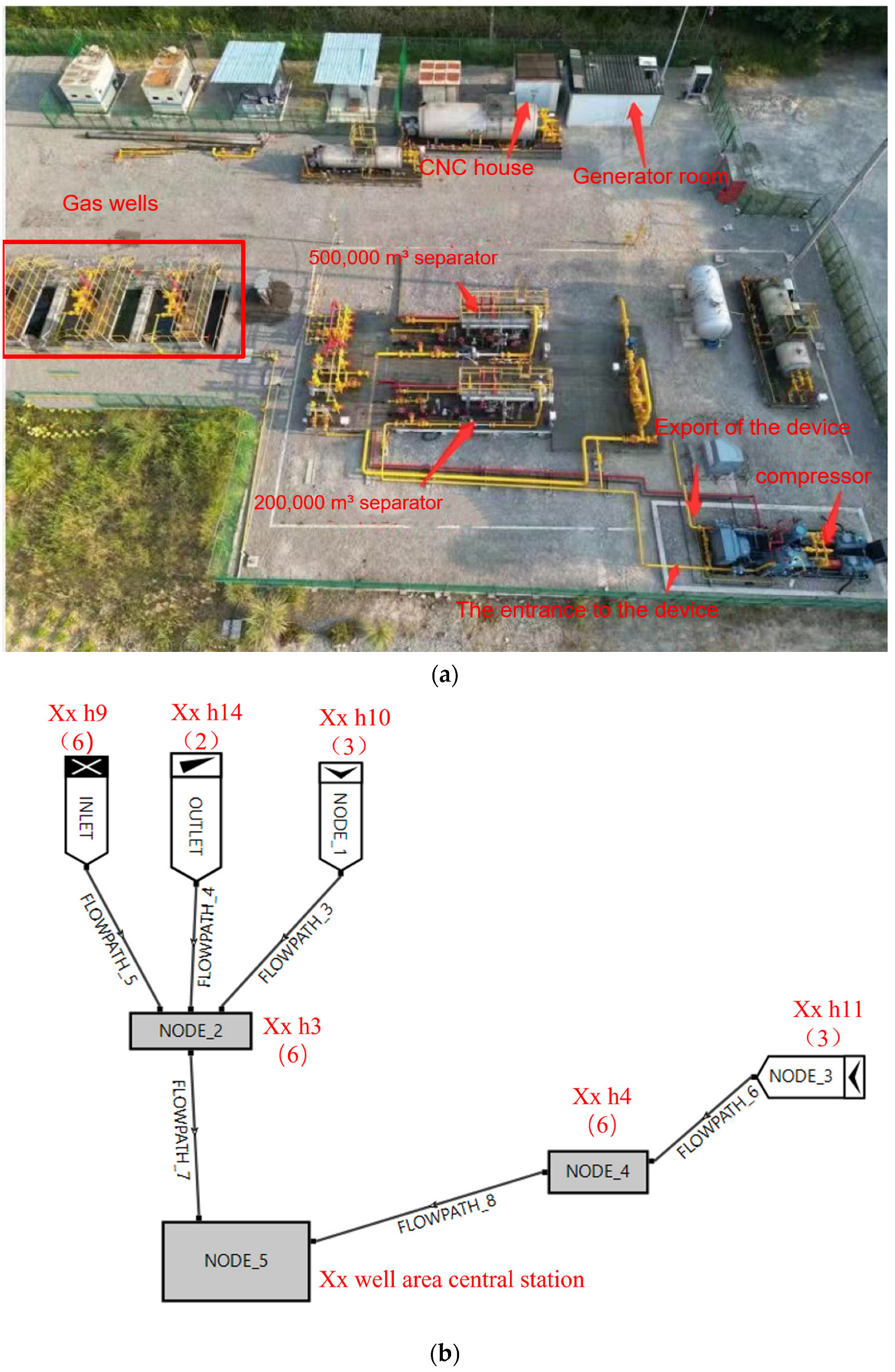


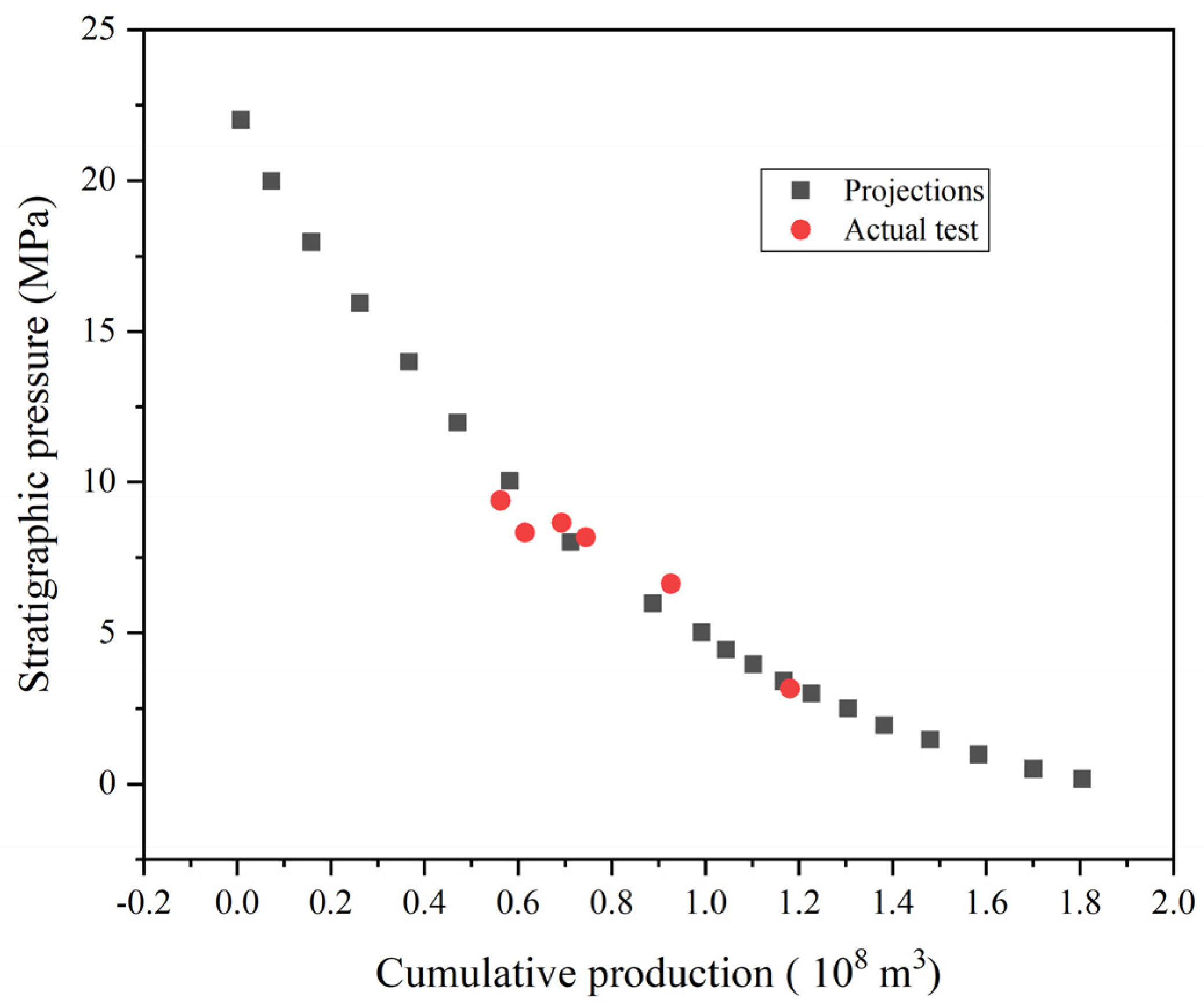
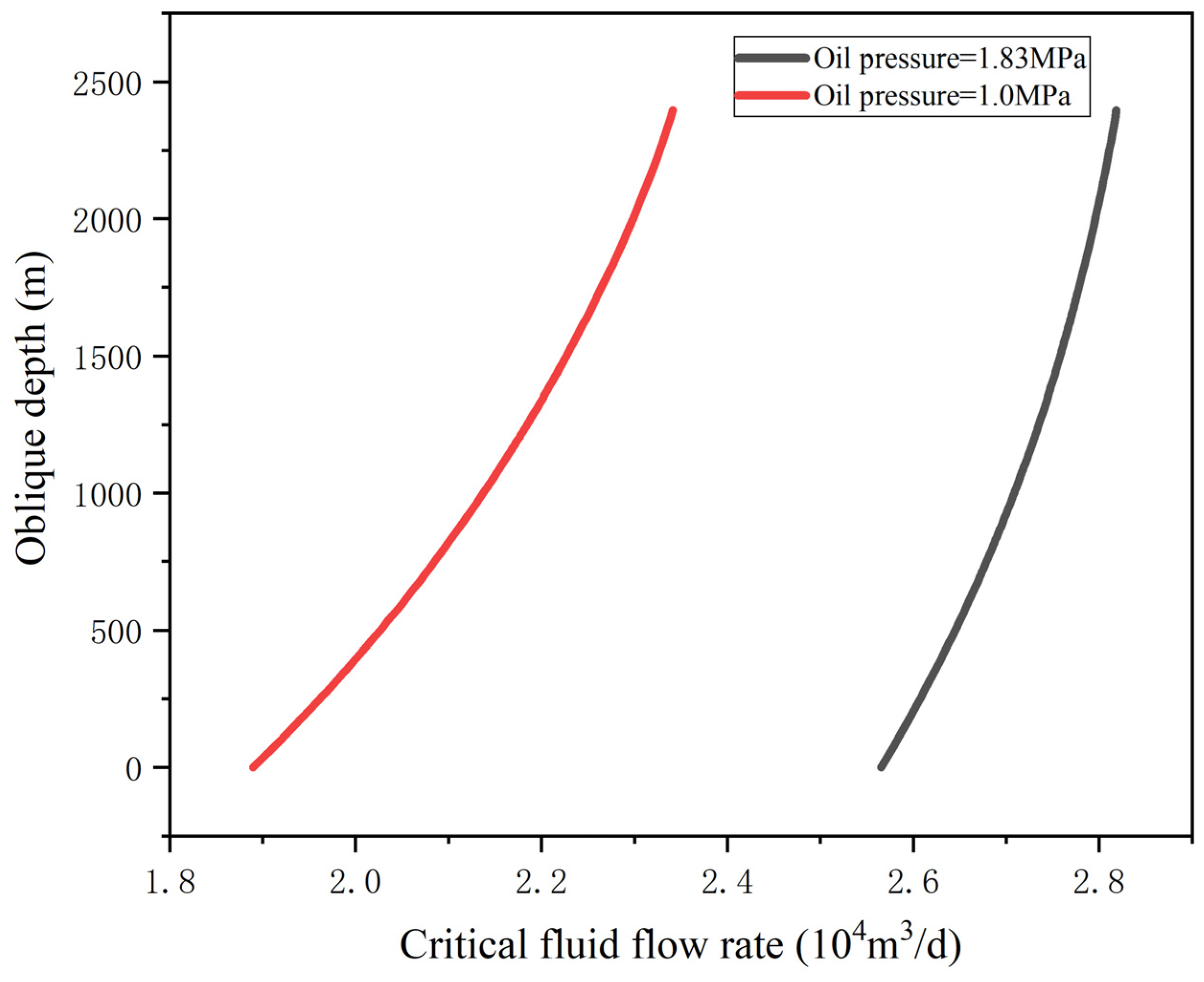
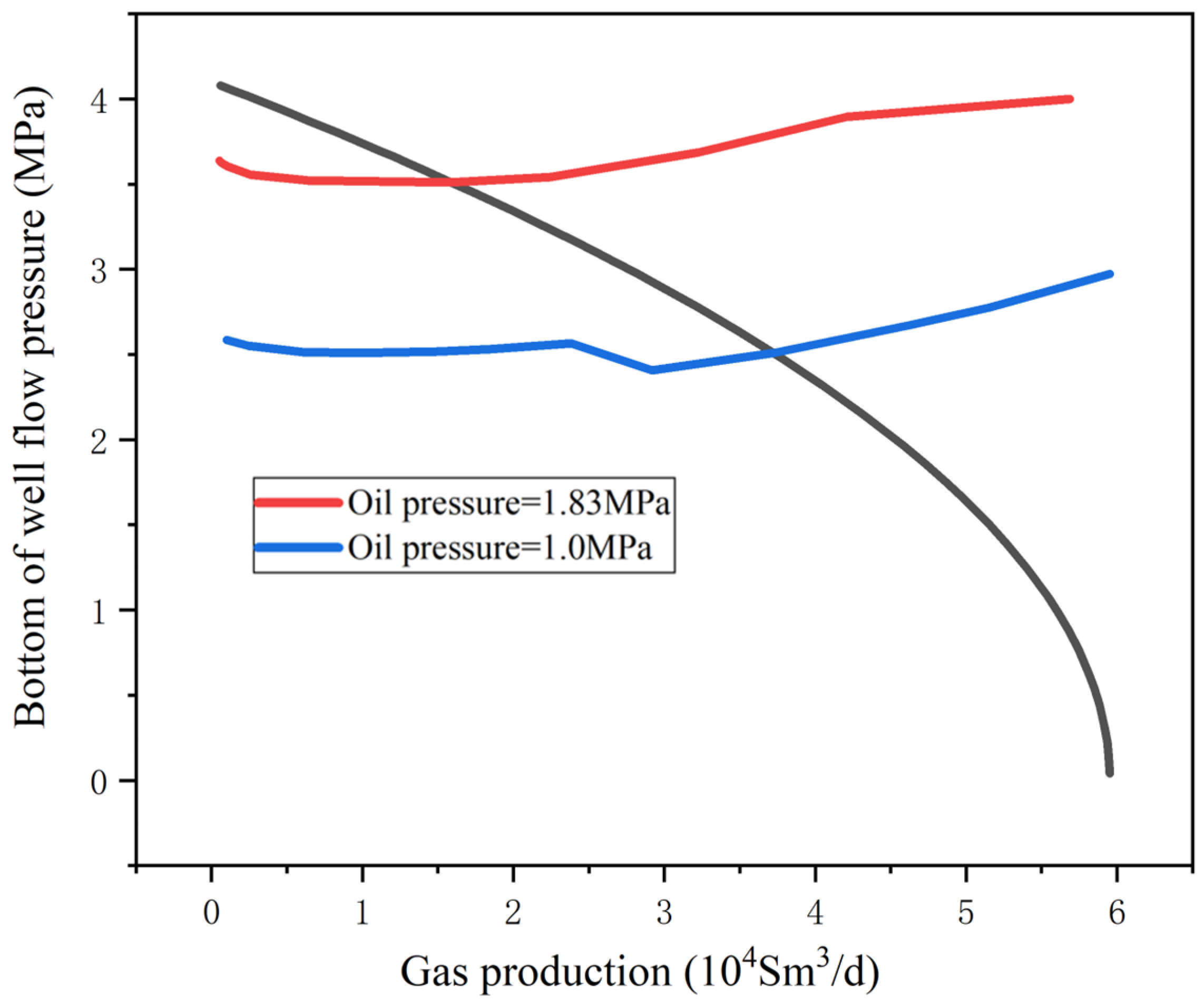
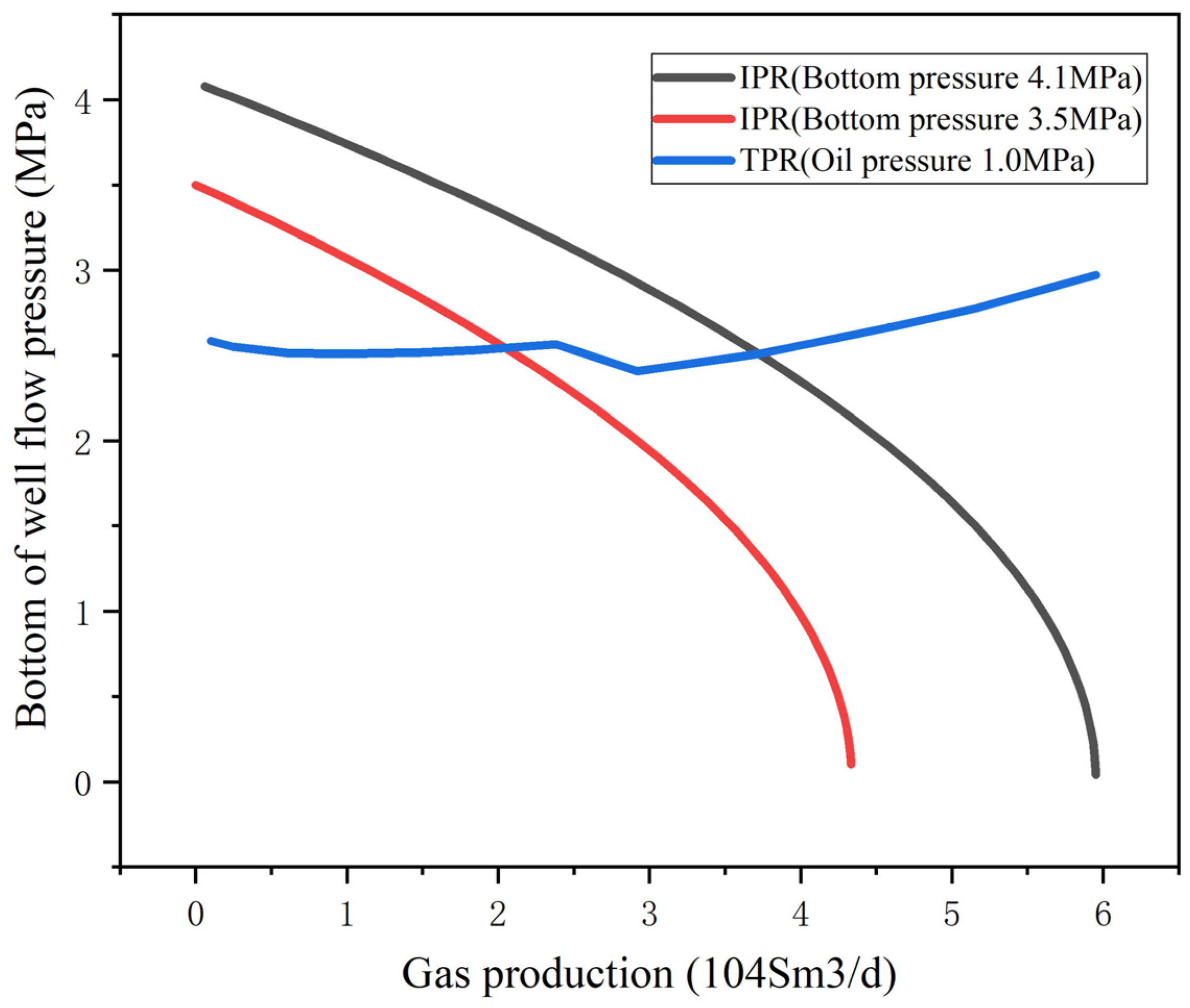
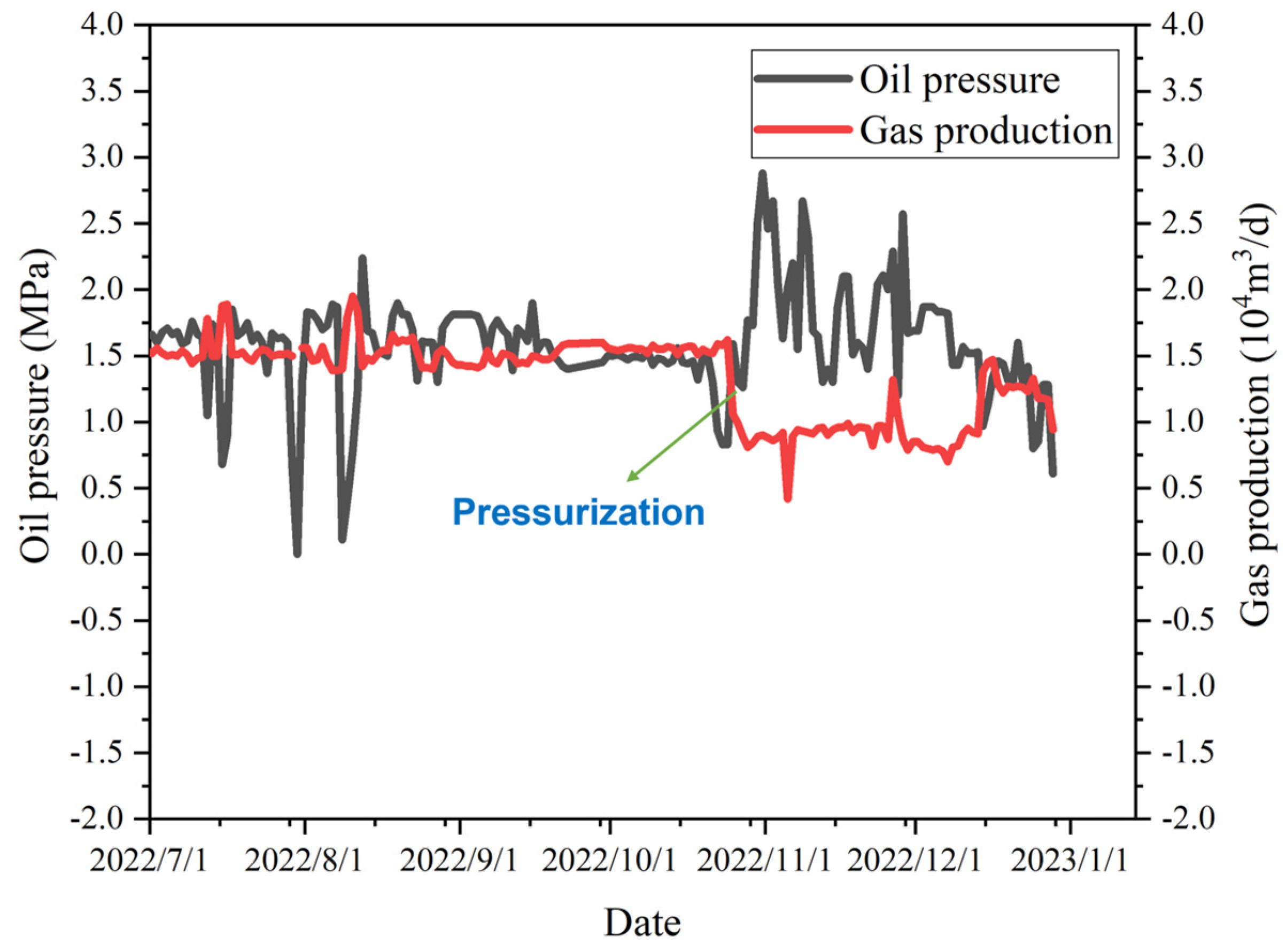
| Stratigraphic Temperature (K) | Crack Height/Shale Thickness (cm) | Uncaused Fracture Infusion Capacity | Shale Matrix Permeability (μm2) | Crack Half-Length (cm) | Fracturing Section Length (cm) | Number of Cracks | Total Epidermal Coefficient |
|---|---|---|---|---|---|---|---|
| 364.93 | 3500 | 10.04 | 3.1 × 10−5 | 10,750 | 136,200 | 19 | 0.0133 |
| Date | Testing Central Pressure (MPa) | Bottom Hole Flow Pressure (MPa) | Daily Gas Production Capacity (105 m3/d) | Average Calculated Formation Pressure (MPa) |
|---|---|---|---|---|
| 20 August 2021 | 2.733 | 2.743 | 1.66 | 3.210 |
| 23 August 2021 | Well shutdown pressure recovery | |||
| 17 September 2021 | 3.344 (Measuring static pressure) | None | 0 | 3.379 (Static pressure) |
| Date | Testing Central Pressure (MPa) | Discounted Bottomhole Flow Pressure (MPa) | Daily Gas Production Capacity (105 m3) | Average Calculated Formation Pressure (MPa) | Cumulative Gas Production (105 m3) |
|---|---|---|---|---|---|
| 14 October 2016 | 7.748 | 8.132 | 12.082 | 9.391 | 5619.912 |
| 8 December 2016 | 7.25 | 7.524 | 7.999 | 8.726 | 6125.840 |
| 24 March 2017 | 7.563 | 7.889 | 7.236 | 8.992 | 6843.317 |
| 19 June 2017 | 8.026 (Static pressure) | 8.226 (Static pressure) | 0 | None | 7451.635 |
| 19 July 2018 | 5.132 | 5.905 | 5.261 | 6.610 | 9209.911 |
| 20 August 2021 | 2.733 | 2.743 | 1.66 | 3.210 | 11,792.283 |
| 17 September 2021 | 3.344 (Static pressure) | 3.379 (Static pressure) | 0 | None | 11,797.364 |
| Stratigraphic Pressure (MPa) | Cumulative Yield (108 m3) | Stratigraphic Pressure (MPa) | Cumulative Yield (108 m3) |
|---|---|---|---|
| 22 | 0 | 4.5 | 1.03712 |
| 20 | 0.06689 | 4 | 1.09471 |
| 18 | 0.15571 | 3.5 | 1.15672 |
| 16 | 0.25955 | 3 | 1.22405 |
| 14 | 0.36432 | 2.5 | 1.29787 |
| 12 | 0.46852 | 2 | 1.37972 |
| 10 | 0.58169 | 1.5 | 1.47155 |
| 8 | 0.7171 | 1 | 1.57597 |
| 6 | 0.88468 | 0.5 | 1.69641 |
| 5 | 0.98323 | 0.1 | 1.8074 |
| Type | Advantages and Disadvantages | |
|---|---|---|
| Reciprocating Compressors | Advantages |
|
| Disadvantages |
| |
| Screw compressors | Advantages |
|
| Disadvantages |
| |
| Star rotary mixer pump | Advantages |
|
| Disadvantages |
| |
| Serial Number | Well Number | Before Booster | After Pressurization | EUR Incremental/108 m3 | ||
|---|---|---|---|---|---|---|
| Abandoned Stratigraphic Pressure/MPa | EUR/108 m3 | Abandoned Stratigraphic Pressure/MPa | EUR/108 m3 | |||
| 1 | Xx H10 −2 | 3.03 | 1.2198 | 2.34 | 1.3231 | 0.1033 |
| 2 | Xx H10 −3 | 3.16 | 1.6269 | 2.43 | 1.6312 | 0.1043 |
Disclaimer/Publisher’s Note: The statements, opinions and data contained in all publications are solely those of the individual author(s) and contributor(s) and not of MDPI and/or the editor(s). MDPI and/or the editor(s) disclaim responsibility for any injury to people or property resulting from any ideas, methods, instructions or products referred to in the content. |
© 2023 by the authors. Licensee MDPI, Basel, Switzerland. This article is an open access article distributed under the terms and conditions of the Creative Commons Attribution (CC BY) license (https://creativecommons.org/licenses/by/4.0/).
Share and Cite
Luo, Y.; Yang, J.; Chen, M.; Yang, L.; Peng, H.; Liang, J.; Zhang, L. Study of Estimated Ultimate Recovery Prediction and Multi-Stage Supercharging Technology for Shale Gas Wells. Separations 2023, 10, 432. https://doi.org/10.3390/separations10080432
Luo Y, Yang J, Chen M, Yang L, Peng H, Liang J, Zhang L. Study of Estimated Ultimate Recovery Prediction and Multi-Stage Supercharging Technology for Shale Gas Wells. Separations. 2023; 10(8):432. https://doi.org/10.3390/separations10080432
Chicago/Turabian StyleLuo, Yanli, Jianying Yang, Man Chen, Liu Yang, Hao Peng, Jinyuan Liang, and Liming Zhang. 2023. "Study of Estimated Ultimate Recovery Prediction and Multi-Stage Supercharging Technology for Shale Gas Wells" Separations 10, no. 8: 432. https://doi.org/10.3390/separations10080432
APA StyleLuo, Y., Yang, J., Chen, M., Yang, L., Peng, H., Liang, J., & Zhang, L. (2023). Study of Estimated Ultimate Recovery Prediction and Multi-Stage Supercharging Technology for Shale Gas Wells. Separations, 10(8), 432. https://doi.org/10.3390/separations10080432






